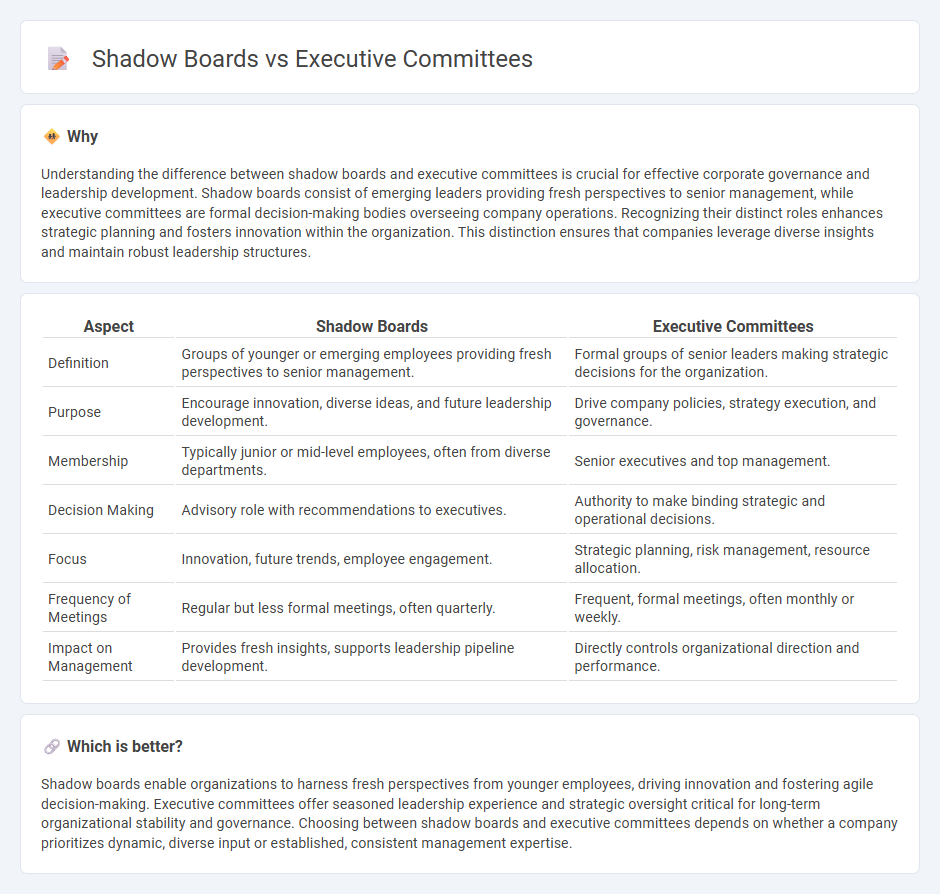
Shadow boards consist of emerging leaders who provide fresh perspectives and innovative solutions, often representing younger employee viewpoints. Executive committees are senior management teams responsible for strategic decision-making and corporate governance. Explore further to understand how integrating shadow boards can enhance traditional leadership structures.
Why it is important
Understanding the difference between shadow boards and executive committees is crucial for effective corporate governance and leadership development. Shadow boards consist of emerging leaders providing fresh perspectives to senior management, while executive committees are formal decision-making bodies overseeing company operations. Recognizing their distinct roles enhances strategic planning and fosters innovation within the organization. This distinction ensures that companies leverage diverse insights and maintain robust leadership structures.
Comparison Table
| Aspect | Shadow Boards | Executive Committees |
|---|---|---|
| Definition | Groups of younger or emerging employees providing fresh perspectives to senior management. | Formal groups of senior leaders making strategic decisions for the organization. |
| Purpose | Encourage innovation, diverse ideas, and future leadership development. | Drive company policies, strategy execution, and governance. |
| Membership | Typically junior or mid-level employees, often from diverse departments. | Senior executives and top management. |
| Decision Making | Advisory role with recommendations to executives. | Authority to make binding strategic and operational decisions. |
| Focus | Innovation, future trends, employee engagement. | Strategic planning, risk management, resource allocation. |
| Frequency of Meetings | Regular but less formal meetings, often quarterly. | Frequent, formal meetings, often monthly or weekly. |
| Impact on Management | Provides fresh insights, supports leadership pipeline development. | Directly controls organizational direction and performance. |
Which is better?
Shadow boards enable organizations to harness fresh perspectives from younger employees, driving innovation and fostering agile decision-making. Executive committees offer seasoned leadership experience and strategic oversight critical for long-term organizational stability and governance. Choosing between shadow boards and executive committees depends on whether a company prioritizes dynamic, diverse input or established, consistent management expertise.
Connection
Shadow boards serve as strategic sounding boards by providing innovative insights from younger or less-experienced employees, complementing the decision-making process of executive committees responsible for steering corporate governance and long-term strategy. This collaboration fosters diverse perspectives, enhancing agility and informed leadership within management structures. Integrating shadow boards with executive committees promotes dynamic organizational alignment, driving effective management outcomes.
Key Terms
Decision-making authority
Executive committees hold formal decision-making authority, directly influencing company strategy and operations. Shadow boards consist of non-executive members who provide strategic advice and alternative perspectives without official decision-making power. Explore the distinctions between these governance structures to optimize organizational decision-making.
Innovation pipeline
Executive committees drive innovation pipelines by leveraging established leadership structures and strategic decision-making processes to allocate resources efficiently and prioritize high-impact projects. Shadow boards, composed of younger or diverse employees, offer fresh perspectives and challenge conventional thinking, fostering creative solutions and enhancing the adaptability of innovation initiatives. Explore how integrating both governance models can accelerate your organization's innovation success.
Generational perspective
Executive committees consist of senior leaders making strategic decisions, reflecting established organizational hierarchies, while shadow boards comprise younger employees who offer fresh insights and challenge conventional thinking, driving innovation through generational diversity. This generational perspective highlights how shadow boards leverage millennial and Gen Z viewpoints to anticipate market trends and adapt to rapidly changing environments more effectively than traditional executive committees. Discover how integrating both structures fosters balanced leadership for sustainable growth.
Source and External Links
What Is the Executive Committee? | Board Portal Glossary - iBabs - An executive committee is a small subset of the board of directors with key officers such as the chairperson, vice-chairperson, treasurer, and secretary, empowered to act on urgent matters between full board meetings and oversee organizational policies and CEO liaison functions.
Executive Committee - Roles + Responsibilities - Board Source - The executive committee helps the board work efficiently by acting on behalf of the full board when necessary, typically including board officers and sometimes committee chairs, facilitating decisions between meetings or during crises.
Executive committee: Responsibilities, Challenges & Tools - The executive committee consists of senior board members who make decisions on behalf of the full board, prioritize issues, set meeting agendas, provide strategic guidance, and may act in emergencies when the full board cannot convene promptly.
 dowidth.com
dowidth.com